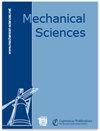A new sensorless control strategy of the PMLSM based on an ultra-local model velocity control system
IF 1.5
4区 工程技术
Q4 ENGINEERING, MECHANICAL
引用次数: 1
Abstract
Abstract. To improve the control performance and dynamic response of the permanent magnet linear synchronous motor (PMLSM), a new sensorless control strategy of the PMLSM with the ultra-local model velocity control system is designed in this paper. Firstly, a model-free speed controller (MFSC) is constructed based on the principle of the ultra-local model. Meanwhile, based on the traditional sliding-mode observer (SMO), the back-electromotive force (BEMF) in the SMO is optimized by the model reference adaptive system (MRAS) to improve the observed speed information of the PMLSM. This control strategy improves the dynamic response ability and stability of the PMLSM system. Compared with the traditional motor control strategy, this design gets rid of the dependence on mechanical sensors, improves the dynamic response ability of the PMLSM, and reduces the velocity tracking error. The superiority of the control system is verified by simulation and experiment. Compared with the traditional dual proportional–integral (PI) control system and SMO, the new control strategy can improve the dynamic response performance of the PMLSM, enhance the stability, and track the speed information of the PMLSM with low error to reduce the chatter.基于超局部模型速度控制系统的PMLSM无传感器控制策略
摘要为了提高永磁直线同步电机的控制性能和动态响应,本文设计了一种基于超局部模型速度控制系统的无传感器控制策略。首先,基于超局部模型原理构造了无模型速度控制器。同时,在传统滑模观测器(SMO)的基础上,通过模型参考自适应系统(MRAS)对SMO中的反电动势(BEMF)进行优化,以提高PMLSM的观测速度信息。该控制策略提高了PMLSM系统的动态响应能力和稳定性。与传统的电机控制策略相比,该设计摆脱了对机械传感器的依赖,提高了PMLSM的动态响应能力,降低了速度跟踪误差。通过仿真和实验验证了该控制系统的优越性。与传统的双比例积分(PI)控制系统和SMO相比,新的控制策略可以提高PMLSM的动态响应性能,增强稳定性,并以低误差跟踪PMLSM速度信息,以减少颤振。
本文章由计算机程序翻译,如有差异,请以英文原文为准。
求助全文
约1分钟内获得全文
求助全文
来源期刊

Mechanical Sciences
ENGINEERING, MECHANICAL-
CiteScore
2.20
自引率
7.10%
发文量
74
审稿时长
29 weeks
期刊介绍:
The journal Mechanical Sciences (MS) is an international forum for the dissemination of original contributions in the field of theoretical and applied mechanics. Its main ambition is to provide a platform for young researchers to build up a portfolio of high-quality peer-reviewed journal articles. To this end we employ an open-access publication model with moderate page charges, aiming for fast publication and great citation opportunities. A large board of reputable editors makes this possible. The journal will also publish special issues dealing with the current state of the art and future research directions in mechanical sciences. While in-depth research articles are preferred, review articles and short communications will also be considered. We intend and believe to provide a means of publication which complements established journals in the field.
 求助内容:
求助内容: 应助结果提醒方式:
应助结果提醒方式:


